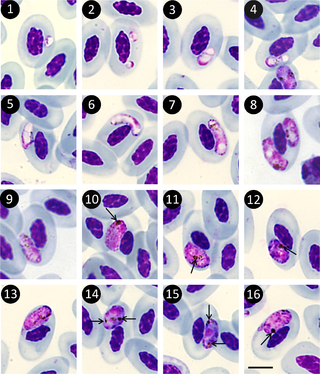
Plasmodium is a genus of unicellular eukaryotes that are obligate parasites of vertebrates and insects. The life cycles of Plasmodium species involve development in a blood-feeding insect host which then injects parasites into a vertebrate host during a blood meal. Parasites grow within a vertebrate body tissue before entering the bloodstream to infect red blood cells. The ensuing destruction of host red blood cells can result in malaria. During this infection, some parasites are picked up by a blood-feeding insect, continuing the life cycle.

The Plasmodiidae are a family of apicomplexan parasites, including the type genus Plasmodium, which is responsible for malaria. This family was erected in 1903 by Mesnil and is one of the four families in the order Haemospororida.
Plasmodium bertii is a parasite of the genus Plasmodium subgenus Papernaia.
Plasmodium booliati is a parasite of the genus Plasmodium subgenus Vinckeia. As in all Plasmodium species, P. booliati has both vertebrate and insect hosts. The vertebrate hosts for this parasite are mammals.
Plasmodium heischi is a parasite of the genus Plasmodium subgenus Sauramoeba. As in all Plasmodium species P. heischi, has both vertebrate and insect hosts. The vertebrate hosts for this parasite are reptiles.
Plasmodium lutzi is a parasite of the genus Plasmodium subgenus Haemamoeba.
Plasmodium fischeri is a parasite of the genus Plasmodium subgenus Lacertamoeba.
Plasmodium pessoai is a parasite of the genus Plasmodium. As in all Plasmodium species, P. pessoai has both vertebrate and insect hosts. The vertebrate hosts for this parasite are reptiles.
Plasmodium tomodoni is a parasite of the genus Plasmodium. As in all Plasmodium species, P. tomodoni has both vertebrate and insect hosts. The vertebrate hosts for this parasite are reptiles.
Plasmodium garnhami is a parasite of the genus Plasmodium.
Plasmodium foleyi is a parasite of the genus Plasmodium subgenus Vinckeia. As in all Plasmodium species, P. foleyi has both vertebrate and insect hosts. The vertebrate hosts for this parasite are mammals.
Plasmodium basilisci is a parasite of the genus Plasmodium subgenus Carinamoeba.
Plasmodium vacuolatum is a parasite of the genus Plasmodium.
Plasmodium gabaldoni is a parasite of the genus Plasmodium subgenus Giovannolaia.
Plasmodium audaciosum is a parasite of the genus Plasmodium.
Plasmodium neusticuri is a parasite of the genus Plasmodium.

The Haemosporida are an order of intraerythrocytic parasitic alveolates.
Plasmodium traguli is a parasite of the genus Plasmodium subgenus Vinckeia. As in all Plasmodium species, P. traguli has both vertebrate and insect hosts. This particular species infects mouse deer in Southeast Asia.
Plasmodium silvaticum is a parasite of the genus Plasmodium subgenus Plasmodium.
Plasmodium carmelinoi is a parasite of the genus Plasmodium.


